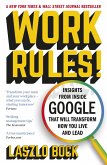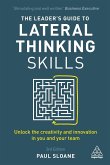Michael Armstrong
How to Be an Even Better Manager
A Complete A-Z of Proven Techniques and Essential Skills
Michael Armstrong
How to Be an Even Better Manager
A Complete A-Z of Proven Techniques and Essential Skills
- Broschiertes Buch
- Merkliste
- Auf die Merkliste
- Bewerten Bewerten
- Teilen
- Produkt teilen
- Produkterinnerung
- Produkterinnerung
Take your practical management skills to the next level with Michael Armstrong's bestselling guide for managers, now in its 11th edition.
Andere Kunden interessierten sich auch für
![Radical Candor Radical Candor]() Kim ScottRadical Candor19,99 €
Kim ScottRadical Candor19,99 €![The Real-Life MBA The Real-Life MBA]() Jack WelchThe Real-Life MBA21,99 €
Jack WelchThe Real-Life MBA21,99 €![Work Rules! Work Rules!]() Laszlo BockWork Rules!10,99 €
Laszlo BockWork Rules!10,99 €![Leader's Guide to Lateral Thinking Skills Leader's Guide to Lateral Thinking Skills]() Paul SloaneLeader's Guide to Lateral Thinking Skills20,99 €
Paul SloaneLeader's Guide to Lateral Thinking Skills20,99 €![Humanity Works Humanity Works]() Alexandra LevitHumanity Works23,99 €
Alexandra LevitHumanity Works23,99 €![The 21 Indispensable Qualities of a Leader The 21 Indispensable Qualities of a Leader]() John C. MaxwellThe 21 Indispensable Qualities of a Leader16,99 €
John C. MaxwellThe 21 Indispensable Qualities of a Leader16,99 €![The New One Minute Manager The New One Minute Manager]() Ken BlanchardThe New One Minute Manager11,99 €
Ken BlanchardThe New One Minute Manager11,99 €-
-
-
Take your practical management skills to the next level with Michael Armstrong's bestselling guide for managers, now in its 11th edition.
Produktdetails
- Produktdetails
- Verlag: Kogan Page
- Artikelnr. des Verlages: 13289
- 11. Aufl.
- Seitenzahl: 304
- Erscheinungstermin: 3. Februar 2021
- Englisch
- Abmessung: 216mm x 140mm x 20mm
- Gewicht: 380g
- ISBN-13: 9781789668322
- ISBN-10: 1789668328
- Artikelnr.: 60438212
- Herstellerkennzeichnung
- Libri GmbH
- Europaallee 1
- 36244 Bad Hersfeld
- gpsr@libri.de
- Verlag: Kogan Page
- Artikelnr. des Verlages: 13289
- 11. Aufl.
- Seitenzahl: 304
- Erscheinungstermin: 3. Februar 2021
- Englisch
- Abmessung: 216mm x 140mm x 20mm
- Gewicht: 380g
- ISBN-13: 9781789668322
- ISBN-10: 1789668328
- Artikelnr.: 60438212
- Herstellerkennzeichnung
- Libri GmbH
- Europaallee 1
- 36244 Bad Hersfeld
- gpsr@libri.de
Michael Armstrong is the UK's bestselling author of Human Resource Management books including Armstrong's Handbook of Human Resource Management Practice and several other titles published by Kogan Page. With over a million copies sold, his books have been translated into twenty-one languages. He is managing partner of E-Reward as well as an independent management consultant. Prior to this he was a chief examiner of the Chartered Institute of Personnel and Development (CIPD) and an HR director of a publishing company.
- Chapter - 01: How to be a better manager;
- Section - ONE: Managing People;
- Chapter - 02: How to treat people right;
- Chapter - 03: How to motivate people;
- Chapter - 04: How to engage people;
- Chapter - 05: How to be a better leader;
- Chapter - 06: How to build teams;
- Chapter - 07: How to manage performance;
- Chapter - 08: How to help people learn and develop;
- Chapter - 09: How to handle difficult situations with people;
- Section - TWO: Management Skills;
- Chapter - 10: How to organize;
- Chapter - 11: How to coordinate;
- Chapter - 12: How to plan and prioritize;
- Chapter - 13: How to control;
- Chapter - 14: How to delegate;
- Chapter - 15: How to make things happen;
- Chapter - 16: How to manage your boss;
- Chapter - 17: How to manage change;
- Chapter - 18: How to manage conflict;
- Chapter - 19: How to deal with office politics;
- Chapter - 20: How to manage a crisis;
- Chapter - 21: How to manage projects;
- Chapter - 22: How to manage time;
- Section - THREE: Personal Skills;
- Chapter - 23: How to persuade;
- Chapter - 24: How to negotiate;
- Chapter - 25: How to make meetings a success;
- Chapter - 26: How to aim high;
- Chapter - 27: How to solve problems and make decisions;
- Chapter - 28: How to be creative and innovate;
- Chapter - 29: How to conduct a selection interview;
- Chapter - 30: How to be interviewed for a job;
- Chapter - 31: How to communicate;
- Chapter - 32: How to listen;
- Chapter - 33: How to make effective presentations;
- Chapter - 34: How to write reports;
- Chapter - 35: How to be strategic;
- Chapter - 36: How to think clearly;
- Chapter - 37: How things go wrong and how to put them right;
- Section - FOUR: Business and Financial Management;
- Chapter - 38: How to be business-like;
- Chapter - 39: How to make a business case;
- Chapter - 40: How to budget;
Chapter
01: How to be a better manager; Section
ONE: Managing People; Chapter
02: How to treat people right; Chapter
03: How to motivate people; Chapter
04: How to engage people; Chapter
05: How to be a better leader; Chapter
06: How to build teams; Chapter
07: How to manage performance; Chapter
08: How to help people learn and develop; Chapter
09: How to handle difficult situations with people; Section
TWO: Management Skills; Chapter
10: How to organize; Chapter
11: How to coordinate; Chapter
12: How to plan and prioritize; Chapter
13: How to control; Chapter
14: How to delegate; Chapter
15: How to make things happen; Chapter
16: How to manage your boss; Chapter
17: How to manage change; Chapter
18: How to manage conflict; Chapter
19: How to deal with office politics; Chapter
20: How to manage a crisis; Chapter
21: How to manage projects; Chapter
22: How to manage time; Section
THREE: Personal Skills; Chapter
23: How to persuade; Chapter
24: How to negotiate; Chapter
25: How to make meetings a success; Chapter
26: How to aim high; Chapter
27: How to solve problems and make decisions; Chapter
28: How to be creative and innovate; Chapter
29: How to conduct a selection interview; Chapter
30: How to be interviewed for a job; Chapter
31: How to communicate; Chapter
32: How to listen; Chapter
33: How to make effective presentations; Chapter
34: How to write reports; Chapter
35: How to be strategic; Chapter
36: How to think clearly; Chapter
37: How things go wrong and how to put them right; Section
FOUR: Business and Financial Management; Chapter
38: How to be business
like; Chapter
39: How to make a business case; Chapter
40: How to budget;
01: How to be a better manager; Section
ONE: Managing People; Chapter
02: How to treat people right; Chapter
03: How to motivate people; Chapter
04: How to engage people; Chapter
05: How to be a better leader; Chapter
06: How to build teams; Chapter
07: How to manage performance; Chapter
08: How to help people learn and develop; Chapter
09: How to handle difficult situations with people; Section
TWO: Management Skills; Chapter
10: How to organize; Chapter
11: How to coordinate; Chapter
12: How to plan and prioritize; Chapter
13: How to control; Chapter
14: How to delegate; Chapter
15: How to make things happen; Chapter
16: How to manage your boss; Chapter
17: How to manage change; Chapter
18: How to manage conflict; Chapter
19: How to deal with office politics; Chapter
20: How to manage a crisis; Chapter
21: How to manage projects; Chapter
22: How to manage time; Section
THREE: Personal Skills; Chapter
23: How to persuade; Chapter
24: How to negotiate; Chapter
25: How to make meetings a success; Chapter
26: How to aim high; Chapter
27: How to solve problems and make decisions; Chapter
28: How to be creative and innovate; Chapter
29: How to conduct a selection interview; Chapter
30: How to be interviewed for a job; Chapter
31: How to communicate; Chapter
32: How to listen; Chapter
33: How to make effective presentations; Chapter
34: How to write reports; Chapter
35: How to be strategic; Chapter
36: How to think clearly; Chapter
37: How things go wrong and how to put them right; Section
FOUR: Business and Financial Management; Chapter
38: How to be business
like; Chapter
39: How to make a business case; Chapter
40: How to budget;
- Chapter - 01: How to be a better manager;
- Section - ONE: Managing People;
- Chapter - 02: How to treat people right;
- Chapter - 03: How to motivate people;
- Chapter - 04: How to engage people;
- Chapter - 05: How to be a better leader;
- Chapter - 06: How to build teams;
- Chapter - 07: How to manage performance;
- Chapter - 08: How to help people learn and develop;
- Chapter - 09: How to handle difficult situations with people;
- Section - TWO: Management Skills;
- Chapter - 10: How to organize;
- Chapter - 11: How to coordinate;
- Chapter - 12: How to plan and prioritize;
- Chapter - 13: How to control;
- Chapter - 14: How to delegate;
- Chapter - 15: How to make things happen;
- Chapter - 16: How to manage your boss;
- Chapter - 17: How to manage change;
- Chapter - 18: How to manage conflict;
- Chapter - 19: How to deal with office politics;
- Chapter - 20: How to manage a crisis;
- Chapter - 21: How to manage projects;
- Chapter - 22: How to manage time;
- Section - THREE: Personal Skills;
- Chapter - 23: How to persuade;
- Chapter - 24: How to negotiate;
- Chapter - 25: How to make meetings a success;
- Chapter - 26: How to aim high;
- Chapter - 27: How to solve problems and make decisions;
- Chapter - 28: How to be creative and innovate;
- Chapter - 29: How to conduct a selection interview;
- Chapter - 30: How to be interviewed for a job;
- Chapter - 31: How to communicate;
- Chapter - 32: How to listen;
- Chapter - 33: How to make effective presentations;
- Chapter - 34: How to write reports;
- Chapter - 35: How to be strategic;
- Chapter - 36: How to think clearly;
- Chapter - 37: How things go wrong and how to put them right;
- Section - FOUR: Business and Financial Management;
- Chapter - 38: How to be business-like;
- Chapter - 39: How to make a business case;
- Chapter - 40: How to budget;
Chapter
01: How to be a better manager; Section
ONE: Managing People; Chapter
02: How to treat people right; Chapter
03: How to motivate people; Chapter
04: How to engage people; Chapter
05: How to be a better leader; Chapter
06: How to build teams; Chapter
07: How to manage performance; Chapter
08: How to help people learn and develop; Chapter
09: How to handle difficult situations with people; Section
TWO: Management Skills; Chapter
10: How to organize; Chapter
11: How to coordinate; Chapter
12: How to plan and prioritize; Chapter
13: How to control; Chapter
14: How to delegate; Chapter
15: How to make things happen; Chapter
16: How to manage your boss; Chapter
17: How to manage change; Chapter
18: How to manage conflict; Chapter
19: How to deal with office politics; Chapter
20: How to manage a crisis; Chapter
21: How to manage projects; Chapter
22: How to manage time; Section
THREE: Personal Skills; Chapter
23: How to persuade; Chapter
24: How to negotiate; Chapter
25: How to make meetings a success; Chapter
26: How to aim high; Chapter
27: How to solve problems and make decisions; Chapter
28: How to be creative and innovate; Chapter
29: How to conduct a selection interview; Chapter
30: How to be interviewed for a job; Chapter
31: How to communicate; Chapter
32: How to listen; Chapter
33: How to make effective presentations; Chapter
34: How to write reports; Chapter
35: How to be strategic; Chapter
36: How to think clearly; Chapter
37: How things go wrong and how to put them right; Section
FOUR: Business and Financial Management; Chapter
38: How to be business
like; Chapter
39: How to make a business case; Chapter
40: How to budget;
01: How to be a better manager; Section
ONE: Managing People; Chapter
02: How to treat people right; Chapter
03: How to motivate people; Chapter
04: How to engage people; Chapter
05: How to be a better leader; Chapter
06: How to build teams; Chapter
07: How to manage performance; Chapter
08: How to help people learn and develop; Chapter
09: How to handle difficult situations with people; Section
TWO: Management Skills; Chapter
10: How to organize; Chapter
11: How to coordinate; Chapter
12: How to plan and prioritize; Chapter
13: How to control; Chapter
14: How to delegate; Chapter
15: How to make things happen; Chapter
16: How to manage your boss; Chapter
17: How to manage change; Chapter
18: How to manage conflict; Chapter
19: How to deal with office politics; Chapter
20: How to manage a crisis; Chapter
21: How to manage projects; Chapter
22: How to manage time; Section
THREE: Personal Skills; Chapter
23: How to persuade; Chapter
24: How to negotiate; Chapter
25: How to make meetings a success; Chapter
26: How to aim high; Chapter
27: How to solve problems and make decisions; Chapter
28: How to be creative and innovate; Chapter
29: How to conduct a selection interview; Chapter
30: How to be interviewed for a job; Chapter
31: How to communicate; Chapter
32: How to listen; Chapter
33: How to make effective presentations; Chapter
34: How to write reports; Chapter
35: How to be strategic; Chapter
36: How to think clearly; Chapter
37: How things go wrong and how to put them right; Section
FOUR: Business and Financial Management; Chapter
38: How to be business
like; Chapter
39: How to make a business case; Chapter
40: How to budget;








